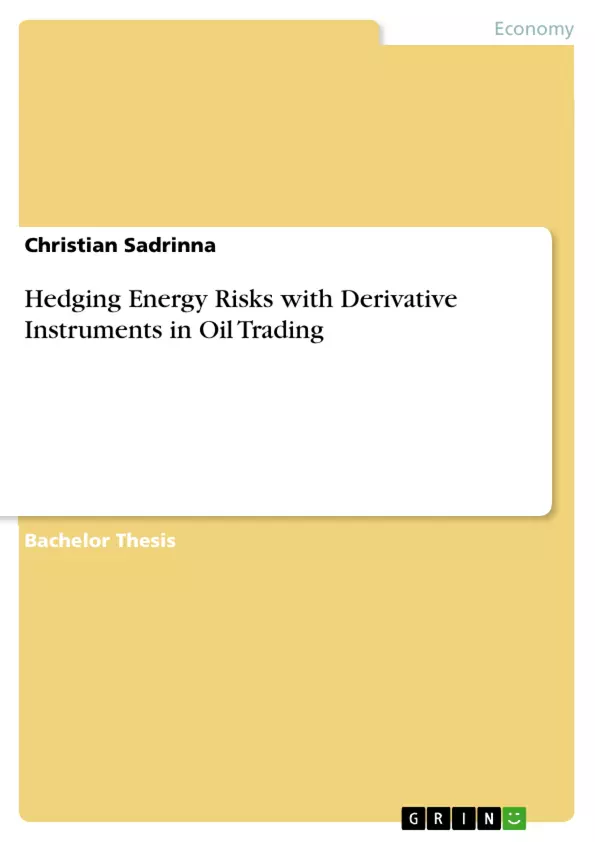The financial crisis has proven how volatile markets can become within a very
shor t period of time. One commodity that went through peaks and troughs is
without doubt oil. A wide range of companies with business activities relying on the commodity and stable pricing, also went through highs and lows, whilst some went into liquidation. This circumstance let many companies think carefully about their risk exposure and how they effectively can manage it. This paper shows that:
The main exercise to mitigate risk is a well-structured risk management operation
which deliver the fundamentals for an effective usage of derivative instruments.
Prior to any securing activity with swaps or options, companies must pin-point
their current risk position, portfolios and their values. On this, the classical portfolio theory with the various modern extensions and portfolio analysis tools deliver a good concept for this question, however, oil has cer tain characteristics which companies need to take into consideration. Furthermore, the portfolio theory may not helping to mitigate risk that is driven by economic factors, hence, spreading risk in an essential part, but some risks can only be addressed other means. All variables may be used to derive, the hedging strategy, time horizon and trading instrument. Especially for the instruments, the paper shows a wide range of commonly used instruments and how they can be applied for distinct oil risk issues.
Inhaltsverzeichnis (Table of Contents)
- 1 Introduction
- 1.1 Problem definition
- 1.2 Objectives
- 1.3 Scope of work
- 2 Trading Motivation and Theoretical Foundation
- 2.1 Risk management
- 2.1.1 Risk definition
- 2.1.2 Portfolio Management
- 2.1.3 Portfolio Analysis
- 2.2 Trading Strategies
- 2.2.1 Hedge Trading
- 2.2.1.1 Direction: Buying- and Selling hedging
- 2.2.1.2 Motive: Asset-, Anticipative- and Strategic hedging
- 2.2.1.3 Coverage: Normal-, Perfect-, Texas and Reversed hedging
- 2.2.1.4 Application: Pure- and Cross hedging
- 2.2.1.5 Scope: Micro-, Macro- and Portfolio hedging
- 2.2.1.6 Adaptation: Static- and Dynamic hedging
- 2.2.2 Arbitrage Trading
- 2.2.3 Speculation
- 2.2.1 Hedge Trading
- 2.1 Risk management
- 3 Commodity Nature and Risk of Oil
- 3.1 Physical characteristics and refining
- 3.2 Market Participants
- 3.2.1 Physical seperation
- 3.2.2 Trading separation
- 3.3 Structure of the Oil Market
- 3.4 Oil pricing arrangements
- 4 Derivative Instruments to mitigate Commodity Risks
- 4.1 Nature of Derivative Instruments
- 4.2 Common Derivative Instruments in Commodity Trading
- 4.2.1 Symmetric transactions
- 4.2.1.1 Forwards
- 4.2.1.2 Futures
- 4.2.1.3 Swaps
- 4.2.2 Asymmetric transactions
- 4.2.2.1 Options
- 4.2.2.2 Swaptions
- 4.2.1 Symmetric transactions
- 5 Risk Mitigation in Practice
- 5.1 Forwards & Futures
- 5.2 Swaps
- 5.3 Options
- 5.4 Swaptions
Zielsetzung und Themenschwerpunkte (Objectives and Key Themes)
This paper investigates the potential of using derivative instruments to hedge energy risks in oil trading, particularly considering the volatility of oil prices. It aims to demonstrate how a well-structured risk management system, incorporating portfolio analysis tools, can enhance the effectiveness of derivative instruments for mitigating risk.- Risk Management Strategies for Oil Trading
- Portfolio Theory and its Applications in Oil Risk Management
- The Use of Derivative Instruments in Hedging Oil Price Volatility
- Different Types of Derivative Instruments and their Suitability for Specific Oil Risks
- Practical Applications of Hedging Strategies Using Forwards, Futures, Swaps, and Options
Zusammenfassung der Kapitel (Chapter Summaries)
The introduction sets the context by highlighting the impact of the financial crisis on oil prices and the need for effective risk management strategies in oil trading. It outlines the objectives and scope of the paper. Chapter 2 delves into the theoretical foundation of trading motivation and risk management. This chapter discusses the significance of risk management, the application of portfolio management and analysis tools, and various trading strategies, including hedge trading, arbitrage trading, and speculation. Chapter 3 focuses on the commodity nature and risks associated with oil. It examines the physical characteristics of oil, the structure of the oil market, and the various market participants. This chapter also explores different oil pricing arrangements. Chapter 4 investigates the role of derivative instruments in mitigating commodity risks. It outlines the nature of derivative instruments and provides a detailed analysis of common instruments used in commodity trading, including forwards, futures, swaps, options, and swaptions. Chapter 5 presents practical examples of risk mitigation strategies using various derivative instruments. This chapter examines the application of forwards and futures, swaps, options, and swaptions in real-world scenarios, providing insights into their effectiveness in hedging against different oil price risks.Schlüsselwörter (Keywords)
This paper focuses on the intersection of risk management, portfolio analysis, and derivative instruments in the context of oil trading. Key terms and concepts include hedging strategies, oil price volatility, commodity risks, portfolio management, and derivative instruments such as forwards, futures, swaps, options, and swaptions.- Citar trabajo
- Christian Sadrinna (Autor), 2010, Hedging Energy Risks with Derivative Instruments in Oil Trading, Múnich, GRIN Verlag, https://www.grin.com/document/151252



